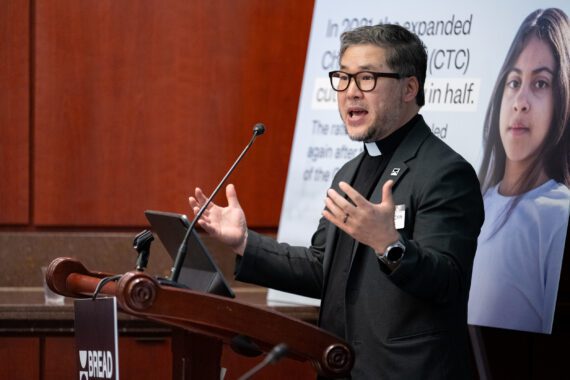By Todd Post
Bread for the World celebrated the March passage of the American Rescue Plan, which includes immediate help for families, small businesses, and local governments devastated by the economic impacts of COVID-19. As I wrote last month, one feature in particular, expanding the Child Tax Credit (CTC), could lead to dramatic reductions in child poverty and hunger.
This piece explained how expanding the CTC makes more grocery money available to parents struggling to put food on the table. The catch is that the American Rescue Plan contains only a one-year expansion. I want to focus now on the need for advocacy to make it permanent. It will take additional effort for the policy improvements to make a lasting difference for children.
Experts project that the CTC expansion will cut child poverty nearly in half and that most (70 percent) of the children no longer living below the poverty line will be Black and/or Latino/a. Major provisions that reduce child poverty include increasing the amount of the benefit, making it available to the millions of low-income households previously excluded, and distributing the benefit in monthly installments. The last point is key since hunger and poor nutrition surge toward the end of each month, when renewed SNAP benefits and/or the next paycheck are at least a week away.
The saying, “The rent eats first” does not mince words: food purchases can be put off, while the rent cannot. A recent pilot initiative, the Stockton (CA) Economic Empowerment Demonstration, gave $500 per month for two years to 125 randomly selected low-income residents of the city of Stockton. A report on the first 12 months found that each month, the largest category of spending was food.
The study supplies evidence of what many people would consider common sense: “Participants regularly described finally being able to afford enough food to cover their household for the entire month, when they previously ran out when monthly food stamps limits were met or when they did not receive enough hours at work.”
Why do anti-hunger advocates expect significant opposition to making the CTC expansion permanent? Cutting child poverty nearly in half and giving parents grocery money they need don’t seem controversial at first glance. The power of stories and stereotypes, whether accurate or not, is one reason. During the debate over the temporary CTC expansion in the American Rescue Plan, prominent critics claimed that it would deter people from taking jobs and ultimately undo what they considered the success of welfare reform.
There is no evidence in support of these claims and strong evidence against them, but opponents are relying on deeply rooted beliefs about why people live in poverty. These beliefs form a narrative that makes it seem entirely possible, even likely, that many or most people will choose not to take jobs if offered $250 a month to help buy groceries.
The Stockton pilot project found that recipients worked more hours, not fewer. Poverty itself makes it harder to find a full-time job. The report on the first year explains: “Shifts in employment patterns were tied to removing material barriers to full-time employment and removing time and capacity limits created by scarcity and [people’s precarious situations]. Material barriers included the ability to reduce the number of part-time shifts or gig work in order to apply for stronger positions.”
Critics of the expansion also assume that if low-income people with increased CTC benefits did in fact work fewer hours, this would be a failure. Yet parents with middle incomes or high incomes are often praised for cutting their work hours to spend more time with their children. A response to opponents of expansion can clearly identify and criticize this double standard.
Another objection to making CTC expansion permanent is a predictable one: cost. The Congressional Research Service has calculated that the one-year expansion in the American Rescue Plan will cost about $110 billion. Opponents will say that the country can’t afford this.
Bread for the World and other anti-hunger advocates have made many effective responses to such claims over the years. One is, of course, the compelling moral argument that anchors our work. The federal budget is a reflection of our priorities, and there should be no higher priority than feeding children. There are also arguments based far less on principle—for example, plain dollars and cents calculations. Studies have established definitively that hunger and poverty cost money, and the entire country bears these costs. One such study, in Bread for the World Institute’s 2016 Hunger Report, showed that at a very conservative estimate, hunger costs the United States more than $160 billion every year.
Under “where to find the money,” there is even a fairly straightforward tax reform policy that would more than pay for this important tax reform policy, to expand the CTC permanently. A team of leading academic researchers report that $175 billion in tax revenue goes uncollected every year, most from the unreported income of multi-millionaires and billionaires. Other researchers concluded that a $100 billion investment in IRS enforcement capacity over 10 years could yield up to $1.2 trillion to $1.4 trillion in additional tax revenue. Enforcing tax laws is a worthwhile policy reform in itself. It is even more worthwhile when it can pay for cutting child poverty nearly in half through permanent CTC expansion.
Todd Post is senior researcher, writer, and editor with Bread for the World Institute.



